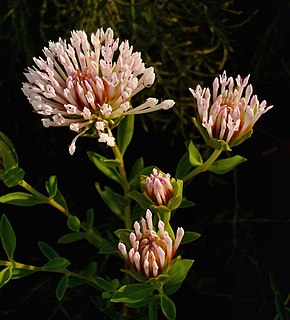
Diuris filifolia, commonly known as the cat's face orchid, is a species of orchid which is endemic to the south-west of Western Australia. It is one of the rarest Diuris in Western Australia, sometimes flowering in large numbers but only after hot summer fires.

Pimelea calcicola is a species of flowering plant in the family Thymelaeaceae and is endemic to part of the west coast of Western Australia. It is an erect to spreading shrub with elliptic leaves arranged in opposite pairs, and head-like racemes of pale to deep pink, tube-shaped flowers surrounded by leaf-like involucral bracts.

Pimelea ferruginea, commonly known as pink rice flower or coastal banjine, is a species of flowering plant in the family Thymelaeaceae and is endemic to near-coastal areas of south-western Western Australia. It is a dense, erect shrub with elliptic to narrowly elliptic leaves and head-like clusters of pale to deep pink, tube-shaped flowers.

Grevillea dryandri is a species of flowering plant in the family Proteaceae and is endemic to northern Australia. It is a spreading to erect shrub with divided leaves with up to seventy or more linear to narrowly elliptic leaves, and long clusters of red, orange-red, pink or white flowers.

Pimelea ciliolaris is a species of flowering plant in the family Thymelaeaceae and is endemic to a restricted area of New South Wales. It is a stunted shrub with narrowly elliptic leaves and heads of densely hairy, cream-coloured to pale yellow flowers.
Thelymitra queenslandica, commonly called the northern sun orchid, is a species of orchid that is endemic to Queensland. It has a single long, grass-like leaf and up to fifteen dark blue to purplish, sometimes white or pinkish flowers with white or pink tufts on top of the anther. It is readily distinguished by its northerly distribution and early flowering period.
Goodenia janamba is a species of flowering plant in the family Goodeniaceae and is endemic to northern Australia. It is an erect herb with linear to lance-shaped leaves mostly at the base of the plant, and umbels or racemes of flowers that are yellow, or purplish with a yellow centre.

Goodenia pilosa is a species of flowering plant in the family Goodeniaceae and is native to northern Australia and to parts of Asia. It is a prostrate to low-lying herb with erect hairs, narrow oblong to narrow elliptic leaves at the base of the plant and racemes of yellow flowers with a purplish base.
Goodenia quadrifida is a species of flowering plant in the family Goodeniaceae and is endemic to a restricted part of the Northern Territory. It is an ascending herb with glabrous foliage, narrow oblong to lance-shaped leaves at the base of the plant and racemes of purplish-brown flowers.

Grevillea goodii, also known as Good's grevillea, is a species of flowering plant in the family Proteaceae and is endemic to the Northern Territory. It is a prostrate shrub with egg-shaped to narrowly elliptic leaves and clusters of light green flowers with a pink to red style.
Grevillea polyacida is a species of flowering plant in the family Proteaceae and is endemic to the Top End of the Northern Territory in Australia. It is an open, erect shrub with egg-shaped leaves, the edges with sharply pointed teeth, and clusters of hairy, greenish flowers.

Lechenaultia filiformis is a species of flowering plant in the family Goodeniaceae and is native to northern Australia and New Guinea. It is a grasslike, ascending herb with scattered, narrow, fleshy leaves and pale purple-blue to creamy-white, tube-shaped flowers.

Pimelea avonensis is a species of flowering plant in the family Thymelaeaceae and is endemic to the south-west of Western Australia. It is a shrub with narrowly egg-shaped or elliptic leaves and clusters of white, tube-shaped flowers.
Pimelea clavata is a species of flowering plant in the family Thymelaeaceae and is endemic to near-coastal areas and offshore islands of southern Western Australia. It is an erect shrub with narrowly elliptic to more or less linear leaves arranged in opposite pairs, and head-like clusters of white to pale yellow, tube-shaped flowers surrounded by leaf-like involucral bracts.
Pimelea concreta is a species of flowering plant in the family Thymelaeaceae and is native to northern Australia and parts of Indonesia. It is an annual herb with narrowly egg-shaped leaves and head-like clusters of white or pink, tube-shaped flowers surrounded by egg-shaped green involucral bracts.

Pimelea cornucopiae is a species of flowering plant in the family Thymelaeaceae and is native to north Queensland and some islands to the north of Australia, New Guinea and the Philippines. It is an erect shrub with egg-shaped leaves and clusters of white or creamy-white flowers.

Schoenia filifolia is a species of flowering plant in the family Asteraceae, and is endemic to the southwest of Western Australia. It is an annual herb with terete leaves and yellow, daisy-like inflorescences.

Pimelea cracens is a species of flowering plant in the family Thymelaeaceae and is endemic to the southwest of Western Australia. It is an erect, spindly shrub with narrowly elliptic to egg-shaped leaves and creamy green to pale yellow flowers surrounded by 6 or 8 yellowish or pale green and reddish involucral bracts.
Pimelea erecta is a species of flowering plant in the family Thymelaeaceae and is endemic to the southwest of Western Australia. It is an erect, often spreading shrub with elliptic to egg-shaped leaves arranged in opposite pairs, and clusters of erect, white or pale pink flowers.
Pimelea eyrei is a species of flowering plant in the family Thymelaeaceae and is endemic to the southwest of Western Australia. It is an erect shrub with hairy, narrowly elliptic leaves and clusters of densely hairy, white or cream-coloured flowers.











